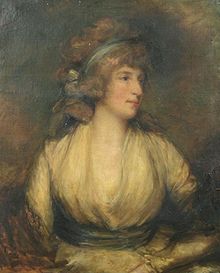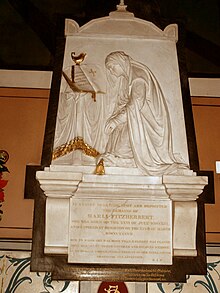Maria Fitzherbert

Maria Anne Fitzherbert (born Smythe , born July 26, 1756 in Brambridge , Hampshire , † March 27, 1837 in Brighton , Sussex ), was an Englishwoman of the Roman Catholic faith and the first wife of the future King George IV of Great Britain . Her marriage, secretly entered into in 1785 after being widowed twice with George IV., Was regarded by the royal family as invalid and therefore never divorced. George IV regarded her as his rightful wife throughout his life.
Life
Maria Anne came from the English gentry and was the eldest child of the married couple Walter Smythe, landlord of Brambridge in Hampshire, and Mary Ann Errington. Her paternal grandparents were Sir John Smythe, 3rd Baronet, and Constantia Blount. Her maternal grandparents were John Errington, landlord of Beaufront, Northumberland, and Maria Levery. She was raised in Paris . She had a sister, Frances Smythe († 1836), who married Sir Carnaby Haggerston, 5th Baronet (1756-1831). Her mother's half-brother was Charles Molyneux, 1st Earl of Sefton .
Mary Anne married in July 1775 the wealthy Catholic landowner Edward Weld (1740-1775), landlord of Lulworth Castle in Dorset , and widower of the Hon. Juliana Petre, daughter of Robert Petre, 8th Baron Petre . Her husband died in a riding accident in 1775 and the marriage remained childless. She married Thomas Fitzherbert (1746–1781), landlord of Swynnerton in Staffordshire and Norbury in Derbyshire , in 1778, the second marriage . Their son Charles William Fitzherbert emerged from the marriage and died young. On the death of her second husband in 1781, she received his London townhouse in Mayfair and had an annual income of £ 2,500.
In the spring of 1784 she was introduced to London's high society by the future king, George, Prince of Wales (1762-1830) . On December 15, 1785, they were secretly married at Red Rice House in Mayfair. The marriage was deemed invalid by the royal family based on the Act of Settlement and the Royal Marriages Act 1772 . For political reasons, the connection remained secret and Fitzherbert promised not to let the public know about it. The Prince of Wales amassed debts through his lavish lifestyle. His father refused to support him unless he married his cousin Caroline von Braunschweig . Prince Georg was forced to move out of his Carlton House residence and live in Maria Fitzherbert's house.
In 1795, Prince George finally gave in and separated from Maria, whom he provided with an annual pension of £ 3,000. He married his cousin Princess Caroline (1768-1821), daughter of Duke Karl Wilhelm Ferdinand of Braunschweig and Princess Augusta of Great Britain , on May 8, 1795 in St. James's Palace . The prince resumed living with Maria Fitzherbert in 1799. In 1804 she had a house called Steine House built in the seaside resort of Brighton right next to the king's residence there, Marlborough House , which she lived in until her death. In 1807 the king finally left her for his new favorite, Isabella Seymour-Conway, Marchioness of Hertford . After the death of George IV in 1830, Maria Fitzherbert's letters were found and steps were taken to destroy them. The new king, William IV. , Agreed to Maria Fitzherbert Duchess to rise, but she refused. She had a warm relationship with Georg's niece, who later became Queen Victoria .
In 1837 she was buried in the Church of St John the Baptist in Brighton; there is also a memorial plaque and her grave monument, which shows her kneeling with three wedding rings (as a sign of the three marriages entered into). In London she was one of the most committed parishioners of the Bavarian legation band Warwick Street Church for many years .
literature
- Charles Langdale: The Memoirs of Mrs Fitzherbert: with an account of her marriage with HRH the Prince of Wales, afterwards King George IV . Richard Bentley, London 1856.
- WH Wilkins: Mrs Fitzherbert and George IV . Longmans, Green, & Co., London, New York and Bombay 1905.
- Sir Shane Leslie: Mrs. Fitzherbert: A Life. Chiefly from Unpublished Sources . 2 volumes. Burns Oates, London 1939-40.
- Anita Leslie: Mrs. Fitzherbert . Hutchinson & Co. Ltd., London 1960; Charles Scribner's Sons, New York 1960.
- Geraldine Simpson: Mrs. Fitzherbert: The Uncrowned Queen . 1971.
- Martin J Levy: The mistresses of King George IV. Peter Owen, London 1996, ISBN 0-7206-0956-9 .
- James Munson: Maria Fitzherbert: The Secret Wife of George IV. Carroll & Graf, New York 2001, ISBN 0-7867-0904-9 .
- Valerie Irvine: The King's Wife: George IV and Mrs Fitzherbert . Hambledon & London, London 2005, ISBN 1-85285-443-X .
- Diane Haeger: The secret marriage . ISBN 3-423-20505-9 .
- Charles Thomas Boothman: Maria Anne Fitzherbert. In: The Catholic Encyclopedia. Volume 6, The Encyclopedia Press, New York 1913, p. 85 ( wikisource ).
Web links
- Maria Anne Smythe on thepeerage.com
Individual evidence
- ^ Reginald Fuller: A short history of Warwick Street Church, formerly the Royal Bavarian Chapel. Catholic Parish Warwick Street Church, London, 1973, p. 39.
| personal data | |
|---|---|
| SURNAME | Fitzherbert, Maria |
| ALTERNATIVE NAMES | Fitzherbert, Maria Anne; Smythe, Maria Ann (maiden name); Weld, Maria Anne |
| BRIEF DESCRIPTION | Wife of King George IV of England |
| DATE OF BIRTH | July 26, 1756 |
| PLACE OF BIRTH | Brambridge |
| DATE OF DEATH | March 27, 1837 |
| Place of death | Brighton |
